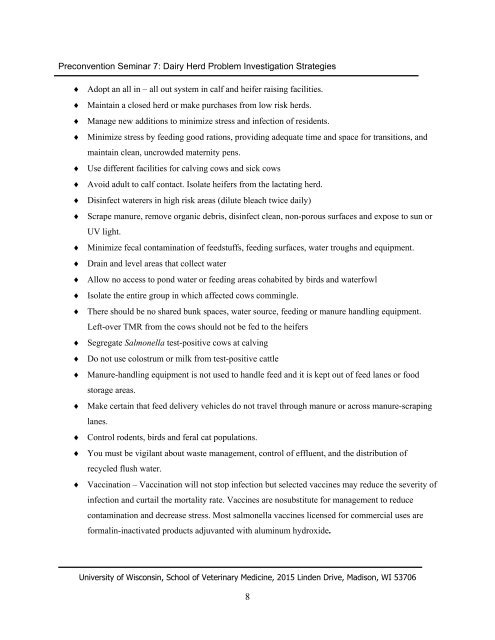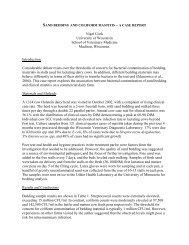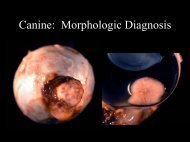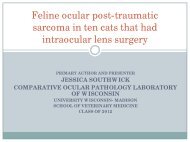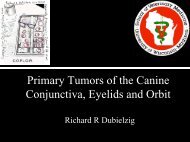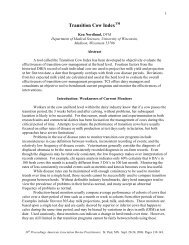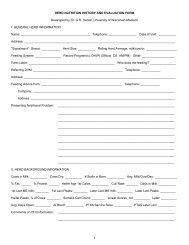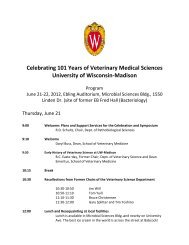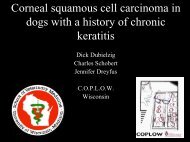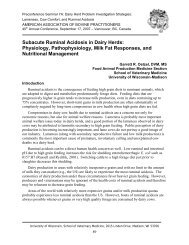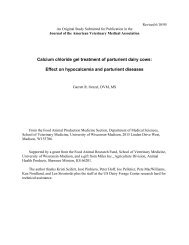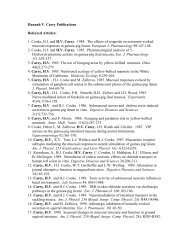Salmonellosis in Cattle: Is There Anything New - University of ...
Salmonellosis in Cattle: Is There Anything New - University of ...
Salmonellosis in Cattle: Is There Anything New - University of ...
Create successful ePaper yourself
Turn your PDF publications into a flip-book with our unique Google optimized e-Paper software.
Preconvention Sem<strong>in</strong>ar 7: Dairy Herd Problem Investigation Strategies<br />
♦ Adopt an all <strong>in</strong> – all out system <strong>in</strong> calf and heifer rais<strong>in</strong>g facilities.<br />
♦ Ma<strong>in</strong>ta<strong>in</strong> a closed herd or make purchases from low risk herds.<br />
♦ Manage new additions to m<strong>in</strong>imize stress and <strong>in</strong>fection <strong>of</strong> residents.<br />
♦ M<strong>in</strong>imize stress by feed<strong>in</strong>g good rations, provid<strong>in</strong>g adequate time and space for transitions, and<br />
ma<strong>in</strong>ta<strong>in</strong> clean, uncrowded maternity pens.<br />
♦ Use different facilities for calv<strong>in</strong>g cows and sick cows<br />
♦ Avoid adult to calf contact. <strong>Is</strong>olate heifers from the lactat<strong>in</strong>g herd.<br />
♦ Dis<strong>in</strong>fect waterers <strong>in</strong> high risk areas (dilute bleach twice daily)<br />
♦ Scrape manure, remove organic debris, dis<strong>in</strong>fect clean, non-porous surfaces and expose to sun or<br />
UV light.<br />
♦ M<strong>in</strong>imize fecal contam<strong>in</strong>ation <strong>of</strong> feedstuffs, feed<strong>in</strong>g surfaces, water troughs and equipment.<br />
♦ Dra<strong>in</strong> and level areas that collect water<br />
♦ Allow no access to pond water or feed<strong>in</strong>g areas cohabited by birds and waterfowl<br />
♦ <strong>Is</strong>olate the entire group <strong>in</strong> which affected cows comm<strong>in</strong>gle.<br />
♦ <strong>There</strong> should be no shared bunk spaces, water source, feed<strong>in</strong>g or manure handl<strong>in</strong>g equipment.<br />
Left-over TMR from the cows should not be fed to the heifers<br />
♦ Segregate Salmonella test-positive cows at calv<strong>in</strong>g<br />
♦ Do not use colostrum or milk from test-positive cattle<br />
♦ Manure-handl<strong>in</strong>g equipment is not used to handle feed and it is kept out <strong>of</strong> feed lanes or food<br />
storage areas.<br />
♦ Make certa<strong>in</strong> that feed delivery vehicles do not travel through manure or across manure-scrap<strong>in</strong>g<br />
lanes.<br />
♦ Control rodents, birds and feral cat populations.<br />
♦ You must be vigilant about waste management, control <strong>of</strong> effluent, and the distribution <strong>of</strong><br />
recycled flush water.<br />
♦ Vacc<strong>in</strong>ation – Vacc<strong>in</strong>ation will not stop <strong>in</strong>fection but selected vacc<strong>in</strong>es may reduce the severity <strong>of</strong><br />
<strong>in</strong>fection and curtail the mortality rate. Vacc<strong>in</strong>es are nosubstitute for management to reduce<br />
contam<strong>in</strong>ation and decrease stress. Most salmonella vacc<strong>in</strong>es licensed for commercial uses are<br />
formal<strong>in</strong>-<strong>in</strong>activated products adjuvanted with alum<strong>in</strong>um hydroxide.<br />
<strong>University</strong> <strong>of</strong> Wiscons<strong>in</strong>, School <strong>of</strong> Veter<strong>in</strong>ary Medic<strong>in</strong>e, 2015 L<strong>in</strong>den Drive, Madison, WI 53706<br />
8


